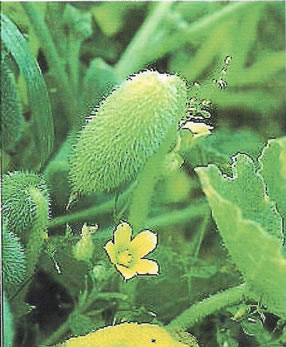1. Introduction
The plant EE, known as squirting cucumber, is a weed belongs to cucurbitacea family. The plant is perennial, fleshy, rough hairy with stems 30 - 100 cm long. The flowers are greenish-yellow and the fruit are large juicy berry, 3 - 4 cm, ovate-oblong, detaching itself explosively at maturity scattering seeds and juice (Figure 1). The plant is widely distributed in the Mediterranean countries. In Jordan, it grows wild in many places including the roadsides and cultivated areas [1].
The fresh juice of EE had been used in folk medicine to treat jaundice since antiquities. Avicenna (980 - 1037) described the use of the juice in his famous book, ALKannon, almost one thousand years ago [2]. Nowadays, the people in Jordan as well as in other countries, are using the juice in the treatment of acute and chronic jaundice, rhinosinusitis, sinusuitis, and other ailments of inflammations [3-8].
The fruit juice of the plant contains several bioactive ingredients such as cucurbitacins. These tetracyclic triterpenoids compounds such as A, E, D, I are of interest medicinally because of their cytotoxic, antitumor and antijaundice properties.
Still these bioactive compounds have been reported to possess other pharmacological activities for example: purgatives, analgesics and hemorrhoids [6,7,9-11].
The purpose of this report is to present a recent review the medical available literature of seventy three human cases as appeared in the Pub-med and other available literature. Further to discuses the possibility of safely use of the plant juice despite its life-threatening adverse effects.
2. Results
Literature Search
Pub med was used to search for patients whom treated by EE juice for jaundice and other ailments. It was possible to allocate 73 different human cases. All of these cases are presented in (Table 1) [Pub-Med: 3,12,14-22]. One

Figure 1. Ecballium elaterium plant (Amman, countryside, Summer, 2010).

Table 1. Reported folkloric cases of patients exposed to Ecballium elaterium fruit juice.
more new case was the Jordanian female of two months old neonate (Personal communication with Professor Najwa Khori of Pediatrics Department, Faculty of Medicine, University of Jordan, Amman, Jordan).
2.1.1. The Folkloric Use
As presented in (Table 1), the plant juice was used to treat: jaundice; chronic sinusitis; acute rhinosinusitis; sinusitis; acute maxillary sinuate; sinusitis and liver cirrhosis.
2.1.2. Administration
The patients were to receive intranasal administration of few undiluted drops of fresh juice.
2.1.3. Age and Sex
The patients were to include males or females of different ages (Table 1).
2.1.4. Adverse Effects of EE Juice
Patients were admitted to the emergency services with various complaints and different signs and symptoms such like: burning sensation, sore throat, difficulty of breathing, soft palate, uvular angioedema, difficulty of swallow, conjunctivitis (eye exposure), allergic reactions, renal and heart failure and even death (Table 1).
2.1.5. Treatment in the Emergency Room
All patients were treated asymptomatically, depends on the signs and symptoms and the condition of the patient. Since, the respiratory system was the major system which was affected by EE Juice, therefore, treatment were to involve the administration of: oxygen, antihistamines, prednisolone, or epinephrine. The eye and skin exposures were treated topically by corticosteroids and antibiotics. Ninety Seven percent of patients were dismissed shortly after recovery (Table 1).
3. Discussion
Jaundice usually comprises a yellow discoloration of the skin and the sclera that produced by accumulations of bilirubin in the tissues and interstitial fluids. It is resulted from increased of bilirubin load and decrease of bilrubin elimination [22,23]. Furthermore, Juandice is still a common physiological problem affecting over half of all fullterm and most preterm infants [23-25]. Although, jaundice is mainly harmless, still the jaundiced of the newborn infant must be monitored for its subsequent consequences such as: hyperbilirunbinemia, acute encephalopathy, and kernictures. At daylight, usually bilirubin becomes visible when the concentration of plasma bilirubin exceeds 2% - 3% mg.The most common causes of jaundice are usually resulted from: increasing of the destruction of red blood cells, the obstruction of the bile ducts and the damage liver hepatocytes [22,23].
The mainstay treatment and intervention of Jaundice is by phototherapy, exchanging transfusion, using of medication such as phenobarbital, baby body massage, and the use of herbal medicine.
The combination of four herbs that sound promising: Artemesia capillaries, Gardenia jasminoides Ellis, Rheum officinale Baill, and Scutellaria baicalensis. This combination is called Yin Zhi Huang combination [25,26]. The use of combination and phenobarbital was found to be useful since phenobarbital induced the activity of the enzyme bilirubin glucoronyltranferase, while, the combination has a potent stimulatory effect on bilirubin clearance through the induction of the activity of the nuclear receptor (CAR) [25]. At the meantime, Huang, et al., 2004 reported that the combination enhances bilirubin clearance by activating the nuclear receptor (androstane receptor, CAR) [25].
However, in our previous investigation using four different animal species models [27], we reported, that EE juice resulted a significant marked decrease in bilirubin presented in the serum in a dose related manor. Therefore, the exact mechanism(s) of the juice has to be clarified in future researches.
4. Conclusion
In conclusion, the nostril administration of EE juice, although resulted of serious adverse reactions and even deaths, of patients, still comprehensive research protocols have to be developed to test the safety and the efficacy of the juice.
5. Acknowledgements
The author would to acknowledge the help of the professor Najwa Khoury for her personal communication, and Khaled A Salhab for his secretarial help.